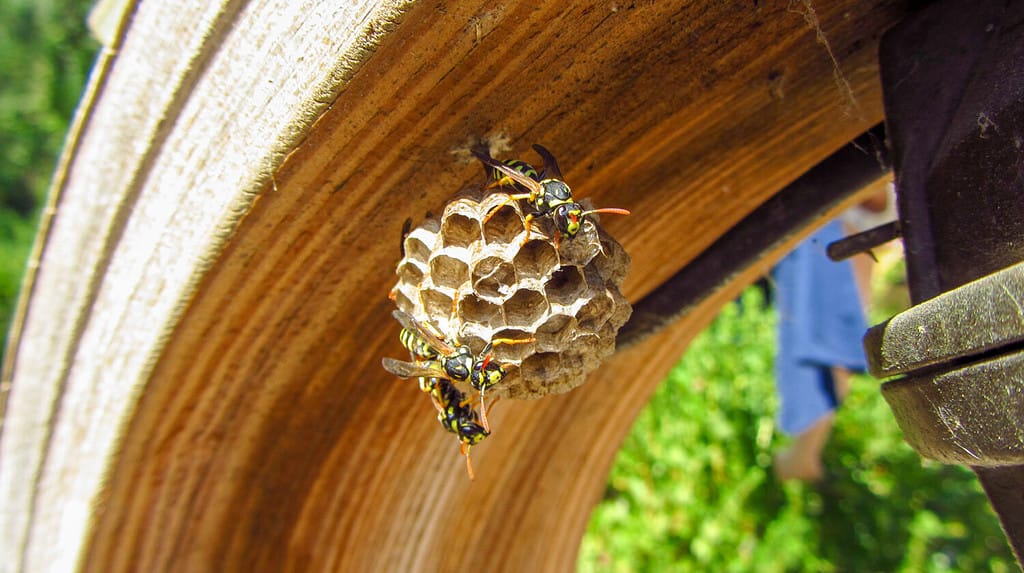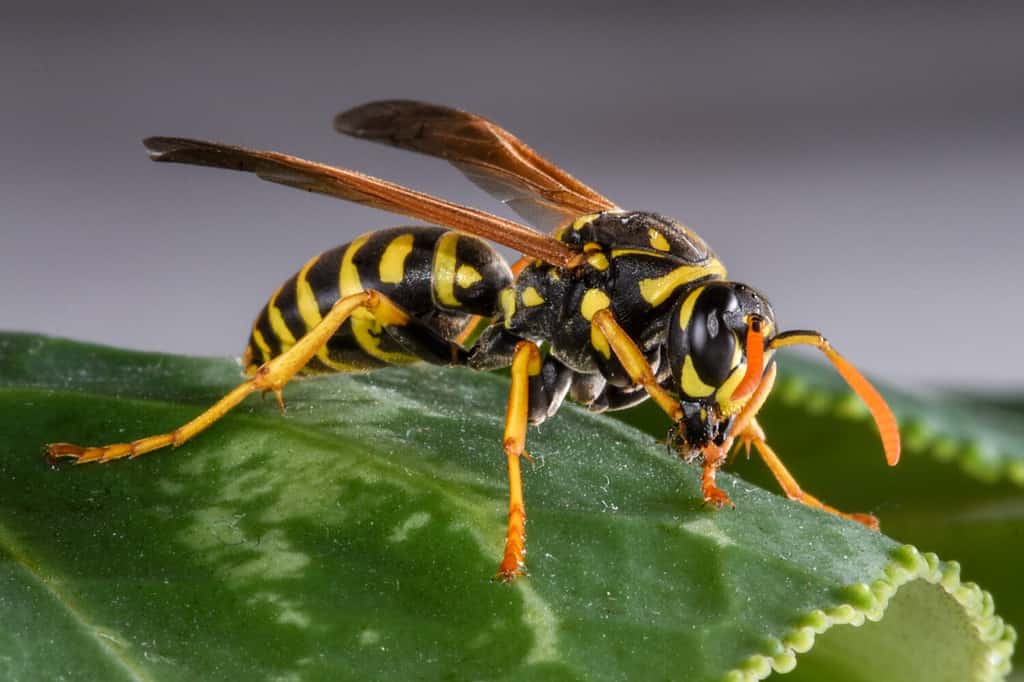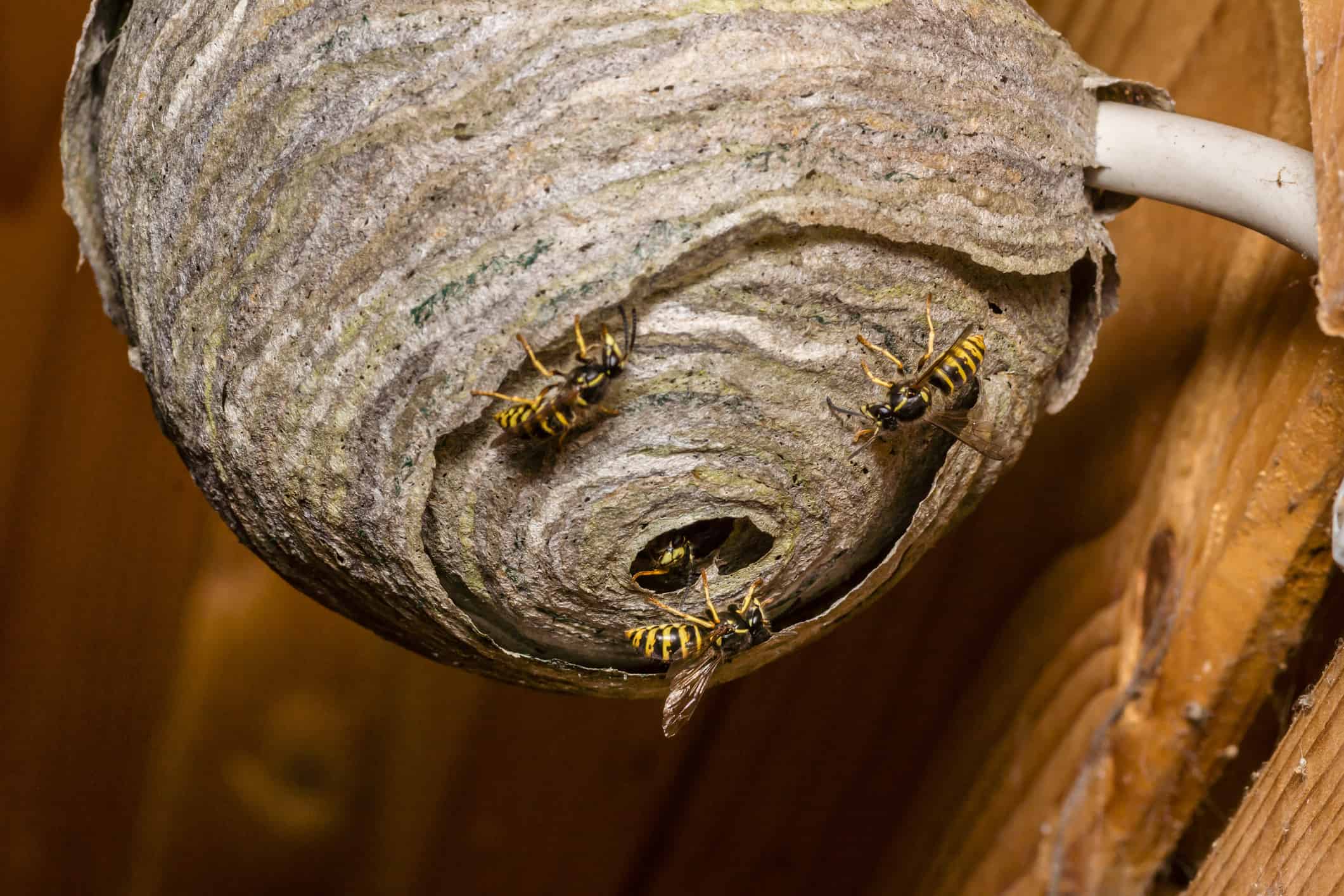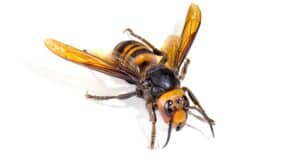Few people stand around in awe of a wasp as it dances and zigzags through their personal space. But come upon an intricate, structurally intriguing wasp nest, and you have an immediate attention-getter. Different species of wasps build different types of nests in different places. Where do wasps nest around you?

Wasps will construct nests anywhere they feel safe and protected.
©OlgaPS/Shutterstock.com
Common Wasp Nest Construction
Wasp nests can range from a tiny clay formation up to a huge paper architectural wonder. Wasps use anything that they consider safe and structurally sound as a nesting spot. One report described a successful wasp nest located in the cavity of an overturned tophat. The size, shape, and location of the constructed nest always give clues as to the species of wasp involved.
Common wasps build nests that are generally conically shaped and beige. The opening to the nest is usually at the center of the bottom. Common wasp nests are found in trees as well as on man-made structures like behind fascia, under soffit boards, or in roof cavities.
European wasp nests are more cylindrical with a larger bottom hole entrance. Also, cavity nesters, European wasp nests are found in barns, outbuilding, attics, hollow trees, and even in some chimney spaces. Median wasps are more likely to build their small, grey, conical nests closer to the ground in bushes or trees. Asian hornets’ nests are grand, pear-shaped spherical structures with an opening along the side.

Mud daubers use mud and clay to form their nests, earning the nickname of potter wasps.
©IrinaK/Shutterstock.com
How Wasps Build Nests
Wasp nests appear similar to paper-maché in their appearance. In contrast to honeybees, who have a wax-producing gland, wasps use their saliva to help produce their building materials. The queen chews old, decayed, and weathered wood, mixing it with her saliva to form a recycled wood pulp. Each mouthful is intricately put into place and shaped through the use of her antennae and mandibles.
The queen first builds a downward stalk. The stalk supports an inverted area that holds the small, tubal structures that each house just a single larva. The outer walls of these hexagonal nurseries connect with precise, 120-degree angled walls. These individual nurseries will soon hatch additional workers. The first nest comb usually holds about 12 cells before the queen surrounds it with curved walls for protection. The queen remains in the nest rearing these workers while laying more eggs. The more workers she has available, the faster the nest will grow.
By looking closely at a wasp nest, you can see and identify the worker’s contributions. Of course, if it’s an active nest, remain a safe distance away and watch the workers as they seemingly never stop moving in and out, either further building the nest, bringing in nutrition for the larva, or removing waste.
An old abandoned nest can be dissected to see how intricate and architecturally sound the building process is. By the end of summer, some nests can house up to 5,000 wasps, but only the queen survives the upcoming winter temperatures. Once the summer is over, the paper nests are abandoned and begin to deteriorate, creating a need to restart the process every spring.

Paper wasps begin their nest construction with a single downward stalk to hold the first comb.
©JorgeOrtiz_1976/Shutterstock.com
The Social Versus Solitary Wasp
With more than 30,000 different species of wasps identified, it would be nearly impossible to go through every species and their nesting habits. But when it comes to these winged marvels, there are two groups, the social wasp and the solitary wasp.
The solitary wasp is by far the biggest group of wasps and includes most of the identified species. They live and function alone, and are many times parasitic, beneficial to agriculture, and used as a natural pest control.
Almost every species of pest insect out there has an identified wasp predator. They can take huge numbers of caterpillars from crops and gardens while performing a small amount of pollinating as well. Additionally, solitary wasps are predatory and seek out spiders and other insects for their consumption. Examples of solitary wasps are potter wasps, cicada killer wasps, and mud dauber wasps.
Social wasps are the typical wasps that we generally run into and encounter daily, yet this category only makes up about 1000 of the 30,000 different species currently identified. Social wasps, as their name implies, work and live together in groups or colonies. Examples include the common wasp, hornets, yellow jackets, and umbrella or paper wasps.

Feeding on a carnivorous diet, yellow jackets primarily prey on other insects like flies and bees.
©Randy Runtsch/Shutterstock.com
Encountering a Wasp Nest
In general, wasp nests should be left alone as the simple sight of a nest does not mean that being near it will produce painful stings. Nest-building social wasps are beneficial to the surrounding area, so it’s considered unwise to destroy nests without a valid reason. Wasps prey upon other landscape pests and play an important role in garden and landscape balance.
If a wasp nest is located near a highly active area, near or on a playground structure, directly outside of your entry and exit ways, or within proximity to people who are sensitive or allergic to the stings, then the nest is a candidate for removal.
Additionally, if the nest is home to problem wasp species, like yellowjackets or other scavenger species that seek sugars or dead insects, they can be a problem while actively searching for food and will retaliate if they feel that they are in danger and threatened. Destruction or removal of wasp nests should be done only by trained professionals.
Thank you for reading! Have some feedback for us? Contact the AZ Animals editorial team.








